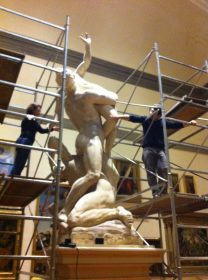
The diagnostics performed on the ‘Ratto delle Sabine’ by Giambologna, at the Galleria dell’Accademia, in Florence, required many skills, since, among others, Xray, UltraSound and Geo-Radar methodologies were employed (with the help of S.T. Art-Test). The results led to unveil and understand some crucial information which was essential to plan and perform the restorative intervention which now taking place under a curtain in the Colosso’s room at the Galleria.
The Colosso is in fact not a copy of the massive statue with is currently under the Loggia dei Lanzi in Piazza della Signoria a Firenze, but an amazing bozzetto, all by Giambologna himself, as large as 4 meters tall.
The subject was reinterpreted as Rape of the Sabine Woman since it was originally intended just as a showcase for the the artist’s ability to create a complex sculptural group including male as female subjects, young and old people in a tribute to Michelangelo’s exquisite formal principle of an ascending spiral.
Diagnostics was intended to see how Giambologna worked, with which materials and techniques, and revealed unexpected facts about the multi-material composition and the very complex internal structure of this massive statue.




